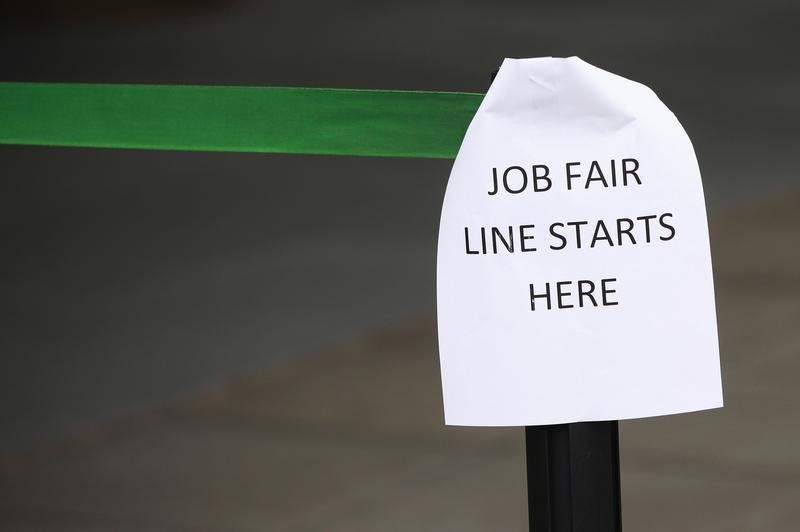(Bloomberg) -- For decades, the U.S. jobless-claims report has provided a straightforward, routine read on the labor market every Thursday. Now it carries a variety of asterisks.
Two sizable reporting errors in as many weeks have inflated the U.S. Labor Department’s nationwide jobless-claims count and the number of applicants under a federal emergency program. On top of that, the report has been beset by data quirks stemming from filing schedules that vary from state to state, as well as seasonal adjustments that have been rendered less useful because of the explosion in layoffs during the coronavirus pandemic.
While it’s not uncommon for claims to be revised, nor will the latest complications alter the bleak and sudden deterioration in the labor market, the errors come at a time when economists and policy makers are attempting to get the best-possible handle on the pandemic’s damage to the economy and the pace of recovery.
“It’s clear you cannot overemphasize or overfocus on any one week of a data point for a particular state given the volatility that we have, given the backlogs that a lot of these states have had to work through,” said Matthew Luzzetti, chief U.S. economist at Deutsche Bank AG (NYSE:DB).
“As states begin to reopen, and as we’ve had this staggered reopening across different states, we will be looking at how that reopening is impacting the pace of improvement in claims,” Luzzetti said.
The latest report was marred by a data-entry error from the Massachusetts labor agency. An official from the state said in an email that it had 115,952 initial claims last week under the separate federal Pandemic Unemployment Assistance program, not the 1,184,792 shown in the U.S. Labor Department’s report.
That means nationwide claims under that program -- which expands unemployment benefits to those not traditionally eligible, such the self-employed and gig workers -- were actually about half of the reported 2.23 million figure. The U.S. Labor Department said it will incorporate the correction into next week’s report.
What Bloomberg’s Economists Say
“Jobless claims should continue to trend down. The pace of declines has been stubbornly slow, but could accelerate given there are tentative signs of small employers rehiring as the economy reopens.”
-- Carl Riccadonna, Yelena Shulyatyeva, Andrew Husby and Eliza Winger
Read more: Bloomberg Economics’s week-ahead preview
A week earlier, Connecticut corrected its count to show 29,846 new claims for the regular state program from a previously reported 298,680, explaining most of a 294,000 downward revision in the U.S. Labor Department’s adjusted figure for the week ended May 9.
Initial jobless claims for regular state programs totaled 2.44 million in the week ended May 16, Labor Department figures showed Thursday. Since efforts to the contain Covid-19 pandemic rapidly shut down the economy in mid-March, about 38.6 million initial unemployment insurance claims have been filed under state programs. That’s roughly equivalent to all of the initial claims filed during the Great Recession, from December 2007 through June 2009.
Differences in how frequently people claim continued benefits in states is yet another reason why it’s become more difficult to get a precise read on week-to-week changes in the labor market at the state level. Economists are monitoring the number of Americans already on benefit rolls to gauge the breadth of the recovery in the labor market as states begin to reopen their economies.
Continuing Claims
These data are lagged by a week, and in the period ended May 9, the majority of states reported an unadjusted decline, a sign that reopenings are putting people back to work in many parts of the country. Yet, total continuing claims jumped an adjusted 2.5 million to a record 25.1 million. The increase was due largely to big unadjusted spikes in California and Florida, and the California rise owes in part to a biweekly filing cycle for aid recipients.
The enormous influx of claims has overwhelmed state unemployment offices. Florida, which has received more than 2 million total claims since March 15, has more than 200,000 filings in its queue awaiting verification. Backlogs have led to delays for millions of Americans across the country in receiving payments, as states scramble to keep up with the unprecedented number of claims.
Read more: Millions in U.S. Are On Edge, Waiting for Jobless Benefits
Errors and differing state reporting methods aside, some economists are looking to the raw numbers for a more accurate read on applications amid challenges with the federal agency’s seasonal adjustment process. On an non-seasonally adjusted basis, initial claims eased to 2.17 million last week from 2.36 million. Continuing claims on that basis totaled 22.9 million for the week ended May 9, up from 20.9 million.
“Given what’s going on is not part of any typical seasonal pattern or anything, I think the NSA data has given you probably a little bit better of a more accurate picture of what’s going on in the data,” Luzzetti said.
©2020 Bloomberg L.P.
